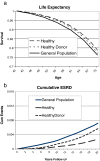Estimating the long term impact of kidney donation on life expectancy and end stage renal disease
- PMID: 23414596
- PMCID: PMC3577426
- DOI: 10.1186/2047-1440-2-2
Estimating the long term impact of kidney donation on life expectancy and end stage renal disease
Abstract
Background: Long term studies of live kidney donation do not show evidence of appreciable risks to the donor. However nephrectomy reduces total glomerular filtration rates (GFR) and is associated with increased rates of proteinuria and possibly hypertension. It is not clear to what extent these changes are associated with reduced life expectancy (LE) or increased risk of end stage renal disease (ESRD) since follow up is incomplete in most reports.
Methods: In a computer simulation model based on a US population chronic kidney disease model, increased hazard rates for higher blood pressure, proteinuria and low GFR were applied to healthy individuals undergoing donor nephrectomy. Subsequent LE and cumulative risk of ESRD were calculated.
Results: Kidney donation is projected to reduce LE by 0.83 years and increase the absolute cumulative risk of ESRD by 0.89% for a 40-year-old white male. White females were predicted to have slightly greater loss of life and less added ESRD risk. Conversely, Blacks have greater risks of ESRD after donation. Older donors with hypertension were predicted to lose less life years and lower cumulative ESRD risks than young donors. Despite these increased risks most donors will have better life expectancy and lower ESRD rates than the general population since they are a highly selected cohort.
Conclusions: This study attempts to quantify increases in death and ESRD from donor nephrectomy assuming the risk factors of hypertension, low GFR and proteinuria have the same significance in this population as in the general population. Further study is required to better estimate the risks of donation and test whether these assumptions are valid.
Figures
References
-
- The Ethics Committee of the Transplantation Society. The consensus statement of the Amsterdam Forum on the Care of the Live Kidney Donor. Transplantation. 2004;78:491–492. - PubMed
-
- Matsushita K, van der Velde M, Astor BC, Woodward M, Levey AS, de Jong PE, Coresh J, Gansevoort RT. Chronic Kidney Disease Prognosis Consortium. Association of estimated glomerular filtration rate and albuminuria with all-cause and cardiovascular mortality in general population cohorts: a collaborative meta-analysis. Lancet. 2010;375:2073–2081. - PMC - PubMed
LinkOut - more resources
Full Text Sources
Other Literature Sources


